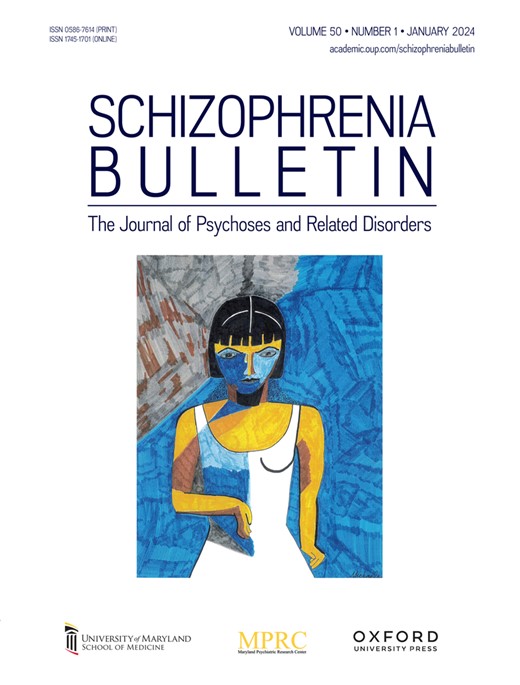DSM诊断和B-SNIP生物型在精神病中的脑年龄差异
IF 5.3
1区 医学
Q1 PSYCHIATRY
引用次数: 0
摘要
背景与假设脑年龄差距(BAG)量化预测脑年龄与实际年龄之间的差异。先前的研究表明,在精神疾病中BAG较高,表明大脑衰老加速。我们假设不同生物学亚型的精神病及其亲属的中度BAG的脑老化特征。研究人员量化了348名健康对照(hc)、950名精神病先证者的脑年龄差距值,这些精神病先证者被DSM诊断为精神病性双相情感障碍I型(BP, n = 247)、分裂情感性障碍(SAD, n = 313)和精神分裂症(SZ, n = 390)、双相-精神分裂症中间表型网络(B-SNIP)生物型(301名生物型1、304名生物型2和345名生物型3),以及491名非精神病一级亲属。我们使用预训练的开源脑年龄包brainageR从结构t1加权图像中计算脑年龄值。在先证中,我们评估了BAG与SZ的临床特征、合并症、药物和多基因风险评分(PRS-SZ)之间的关系。研究结果DSM诊断组和生物型组BAG均高于HC组。虽然BP、SAD和SZ之间没有显著差异,但生物型1和2的BAG明显高于生物型3。亲属的BAG值介于HC和先证者之间,SAD亲属的BAG值最高。脑年龄差距与合并症或PRS-SZ无关,但与症状严重程度、认知、功能和精神药物使用有关。结论双相-精神分裂症中间表型网络生物型比DSM诊断更能捕捉到与年龄相关的精神病脑结构差异。BAG和药物之间的关联强调了药物治疗对精神病患者脑衰老的潜在影响。本文章由计算机程序翻译,如有差异,请以英文原文为准。
Brain Age Disparities in Psychosis Across DSM Diagnoses and B-SNIP Biotypes
Background and Hypothesis The brain age gap (BAG) quantifies the difference between predicted brain age and chronological age. Prior research implicates higher BAG in psychotic disorders, suggesting accelerated brain aging. We hypothesized distinct brain aging profiles among biological subtypes of psychosis and intermediate BAG in their relatives. Study Design Brain age gap values were quantified in 348 healthy controls (HCs), 950 psychosis probands classified by both DSM diagnoses of psychotic bipolar disorder, type I (BP, n = 247), schizoaffective disorder (SAD, n = 313), and schizophrenia (SZ, n = 390), and Bipolar-Schizophrenia Network for Intermediate Phenotypes (B-SNIP) Biotypes (301 Biotype 1, 304 Biotype 2, and 345 Biotype 3), and 491 of their non-psychotic first-degree relatives. We calculated brain age values from structural T1-weighted images using the pre-trained, open-source brain age package, brainageR. In probands, we assessed associations between BAG and clinical characteristics, comorbid disorders, medications, and polygenic risk scores for SZ (PRS-SZ). Study Results All DSM diagnosis and Biotype groups had higher BAG than HC. While no significant differences were observed between BP, SAD, or SZ, Biotypes 1 and 2 had significantly higher BAG compared to Biotype 3. Relatives exhibited intermediate BAG values between HC and probands, with the highest BAG in relatives of those with SAD. Brain age gap was not linked to comorbid disorders or PRS-SZ, but was associated with symptom severity, cognition, functioning, and psychotropic medication use. Conclusions Bipolar-Schizophrenia Network for Intermediate Phenotypes Biotypes better captured age-related brain structural differences in psychosis than DSM diagnoses. Associations between BAG and medication underscore the potential influence of pharmacotherapy on brain aging in psychosis.
求助全文
通过发布文献求助,成功后即可免费获取论文全文。
去求助
来源期刊

Schizophrenia Bulletin
医学-精神病学
CiteScore
11.40
自引率
6.10%
发文量
163
审稿时长
4-8 weeks
期刊介绍:
Schizophrenia Bulletin seeks to review recent developments and empirically based hypotheses regarding the etiology and treatment of schizophrenia. We view the field as broad and deep, and will publish new knowledge ranging from the molecular basis to social and cultural factors. We will give new emphasis to translational reports which simultaneously highlight basic neurobiological mechanisms and clinical manifestations. Some of the Bulletin content is invited as special features or manuscripts organized as a theme by special guest editors. Most pages of the Bulletin are devoted to unsolicited manuscripts of high quality that report original data or where we can provide a special venue for a major study or workshop report. Supplement issues are sometimes provided for manuscripts reporting from a recent conference.
 求助内容:
求助内容: 应助结果提醒方式:
应助结果提醒方式:


